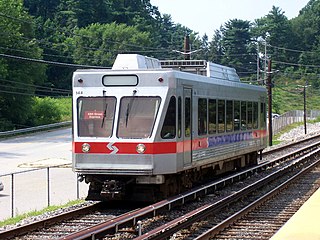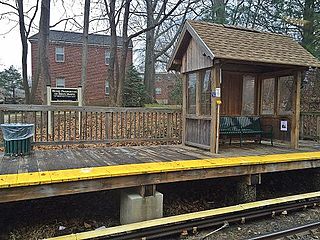
The Southeastern Pennsylvania Transportation Authority (SEPTA) is a regional public transportation authority that operates bus, rapid transit, commuter rail, light rail, and electric trolleybus services for nearly four million people in five counties in and around Philadelphia, Pennsylvania. It also manages projects that maintain, replace and expand its infrastructure, facilities and vehicles.

The Norristown High Speed Line is a 13.4-mile (21.6 km) interurban light rapid transit line operated by SEPTA, running between the 69th Street Transportation Center in Upper Darby and the Norristown Transportation Center in Norristown, Pennsylvania. Originally the Philadelphia and Western Railroad line, the line runs entirely on its own right-of-way. By 2020, the Norristown High Speed Line had an average weekday ridership approaching 11,000 passengers.

The Philadelphia and Western Railroad was a high-speed, third rail-equipped, commuter-hauling interurban electric railroad operating in the western suburbs of Philadelphia, Pennsylvania. It is now SEPTA's Norristown High Speed Line, though the Strafford spur has been abandoned. Part of the abandoned line within Radnor Township is now the Radnor Trail, a multi-use path or rail trail.

The SEPTA Regional Rail system is a commuter rail network owned by SEPTA and serving the Philadelphia metropolitan area. The system has 13 branches and more than 150 active stations in Philadelphia, Pennsylvania, its suburbs and satellite towns and cities. It is the sixth-busiest commuter railroad in the United States, and the busiest outside of the New York, Chicago, and Boston metropolitan areas. In 2016, the Regional Rail system had an average of 132,000 daily riders and 118,800 daily riders as of 2019.

Transportation in Philadelphia involves the various modes of transport within the city and its required infrastructure. In addition to facilitating intracity travel, Philadelphia's transportation system connects Philadelphia to towns of its metropolitan area and surrounding areas within the Northeast megalopolis.

SEPTA Routes 101 and 102 are light rail lines operated by the Suburban Transit Division of the Southeastern Pennsylvania Transportation Authority, serving portions of Delaware County. The route's eastern terminus is 69th Street Transportation Center in Upper Darby Township, Pennsylvania. Route 101 runs to Media, while Route 102 goes to Sharon Hill. Altogether, the two lines operate on approximately 11.9 miles (19.2 km) of route. The lines are one of the few remaining interurban systems in the United States, along with the South Shore Line in Indiana, the River Line in New Jersey, and the Norristown High Speed Line, also in the Philadelphia area.

The 69th Street Transportation Center is a SEPTA terminal in the Terminal Square section of Upper Darby Township, Pennsylvania. It serves the Market–Frankford Line, Norristown High Speed Line, and SEPTA Routes 101 and 102 trolleys, and multiple bus routes. It is located at the end of 69th Street, a major retail corridor in Upper Darby Township across Market Street from the Tower Theater. Until 2011, the station was primarily known as 69th Street Terminal.

Norristown Transportation Center is a two-level multimodal public transportation regional hub located in Norristown, Pennsylvania and operated by SEPTA. It opened in 1989, replacing the older Norristown High Speed Line terminus one block away at Main and Swede Streets, and integrated the former Reading Company's DeKalb Street Norristown railroad station into its structure. A plaque embedded in the sidewalk between the bus lane and Lafayette Street commemorates the location of one of the columns of the dismantled segment of the Philadelphia and Western Railroad (P&W) trestle.

Beechwood–Brookline station is a SEPTA rapid transit station in Haverford Township, Pennsylvania. It serves the Norristown High Speed Line and is located at Edgewood and Strathmore Roads, although SEPTA gives the address as Beechwood and Karakung Drives. All trains stop at Beechwood–Brookline. The station lies 2.5 track miles (4.0 km) from 69th Street Terminal. The station has off-street parking available.

Ardmore Avenue station is a SEPTA rapid transit station in Ardmore, Pennsylvania. It serves the Norristown High Speed Line, and is located at Ardmore Avenue and Haverford Road. All trains stop at Ardmore Avenue. The station lies 3.9 track miles (6.3 km) from 69th Street Transportation Center. The station has off-street parking available.

Roberts Road station, formerly Rosemont station, is a SEPTA rapid transit station in Rosemont, Pennsylvania. It serves the Norristown High Speed Line and is located at Roberts Road and David Drive in Radnor Township, Pennsylvania. All trains stop at Roberts Road. The station lies 5.9 track miles (9.5 km) from 69th Street Terminal.

Villanova station is a SEPTA rapid transit station near the campus of Villanova University in Radnor Township, Pennsylvania. It serves the Norristown High Speed Line. All trains stop at Villanova. The station lies 7 track miles (11 km) from 69th Street Terminal. The station has off-street parking available.

Bridgeport station is a SEPTA rapid transit station in Bridgeport, Pennsylvania. It serves the Norristown High Speed Line. The station is located on Sixth Street near DeKalb Street, although SEPTA's official website gives the address as being near 5th and Merion Streets. All trains stop at Bridgeport. The station lies 12.8 track miles (20.6 km) from 69th Street Terminal.

SEPTA's Trolley Route 60, the Allegheny Avenue Line is a former streetcar line and current bus route, operated by the Southeastern Pennsylvania Transportation Authority (SEPTA) in Northwest and Northeast Philadelphia, Pennsylvania, United States. It connects to the East Falls to the Port Richmond, and runs primarily along Allegheny Avenue.

SEPTA Route 75 is a trackless trolley route operated by SEPTA in North and Northeast Philadelphia, Pennsylvania, United States. It connects to the Market–Frankford Line at Arrott Transportation Center Station, and runs primarily along Wyoming Avenue. Route 75 connects to the Wyoming local line and goes to Wayne Junction in Nicetown.

SEPTA Route 103 is a bus route operated by the Southeastern Pennsylvania Transportation Authority (SEPTA) on the outskirts of Philadelphia, Pennsylvania, United States. Route 103 runs between Ardmore and the 69th Street Transportation Center in Upper Darby.

The Cynwyd Line is a SEPTA Regional Rail line from Center City Philadelphia to Cynwyd in Montgomery County, Pennsylvania. Originally known as the Ivy Ridge Line, service was truncated on May 17, 1986, at its current terminus at Cynwyd.

The Manayunk/Norristown Line is a commuter rail service in Southeastern Pennsylvania between Center City Philadelphia and Norristown, and one of the 13 lines in SEPTA's Regional Rail network. It has the second highest operating ratio (19.9%) on the SEPTA Regional Rail network.

The Fox Chase Line is a SEPTA Regional Rail service connecting Center City Philadelphia with Fox Chase. It uses the Fox Chase Branch, which branches off from the SEPTA Main Line at Newtown Junction north of the Wayne Junction station. It runs entirely within the city of Philadelphia. The line is fully grade-separated, except for one grade crossing on Oxford Avenue.

The Chestnut Hill East Line is a route of the SEPTA Regional Rail system. The route serves the northwestern section of Philadelphia with service to Germantown, Mount Airy, and Chestnut Hill. It is one of two lines that serve Chestnut Hill, the other one being the Chestnut Hill West Line. The line is fully grade-separated.






















